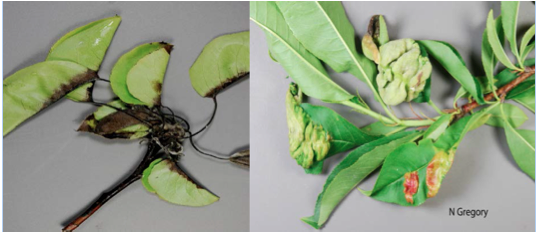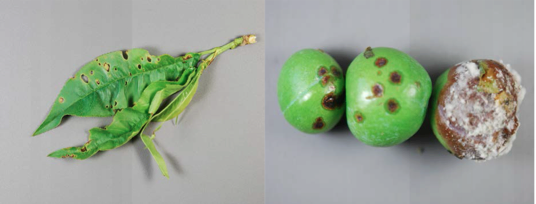
Fact Sheets And Publications

Home Orchard Production – Apple, Pear, and Stone Fruit Disease Management
Growing fruit in a backyard or home orchard can be rewarding or can be very frustrating, depending on disease and insect pests that may be present. While it is tempting to plant fruit trees and not apply chemical control measures, it is often impractical, and the resulting fruit crop may be disappointing or not result in any harvestable fruit. Various diseases affect fruit, and some are caused by fungi while some are caused by bacteria and viruses, so accurate examination and diagnosis is important. Disease development is dependent on the host, pathogen, and a suitable environment (mainly temperature and moisture). Controls may include preventative (protectant) fungicides, but availability and labels may vary for different states, and label directions must always be followed.
The most common tree fruits grown in home orchards are apples, pears (European and Asian), and stone fruits (peaches, nectarines, plums, apricots, pluots, and cherries). Apple trees are commonly affected by fire blight, apple scab, fruit rots, rusts, and powdery mildew. Fire blight is a common problem in pears. Stone fruits are affected by peach leaf curl, bacterial spot, brown rot, scab, and leaf spot.

- Left: Fire Blight on Pear, Right: Peach Leaf Curl, Images by N. Gregory

- Left: Bacterial Leaf Spot on Peach, Right: Brown Rot Pluot, Images by N. Gregory
Disease Control and Management
The use of resistant cultivars is one of the best disease control options, and may give good yields of fruit with the least amount of management. Only peach and nectarine varieties with bacterial spot resistance should be grown in Delaware. Some yellow varieties with resistance include Sentry, John Boy, Ernies Choice, Bounty, Cresthaven, Red Haven, Encore, and Autumn Star. Sugar May, July Rose, Raritan Rose and Blushing Star are resistant white varieties. Avalon and Nectafest are resistant yellow nectarines and Silver Gem, Jade, Emeraude, and Zephyr are resistant white nectarines. A few varieties of apple that are resistant to apple scab and perform well in Delaware include Crimson Crisp, Enterprise, and Gold Rush. A good list may be found from http://extension.psu.edu/plants/tree-fruit/commercial-tree-fruit-production/cultivars-and-rootstocks/scab-resistant-cultivars. Only fireblight resistant pears should be grown in Delaware and include the European types Sunrise, Blakes Pride, Seckel, Magness, Potomac and Shenandoah and the Asian Pears Kosui, Olympic, Shinko, and Shinsui. See this Purdue University site for more information on fire blight resistant apples and pears https://www.extension.purdue.edu/extmedia/BP/BP-30-W.pdf.
For home orchards, chemical control and yearly pruning may be difficult but should be considered. Proper soil preparation, avoiding poorly drained areas, planting so that graft unions are well above the soil surface, avoiding compacted soils, proper site choice, and spacing for good air movement are important cultural strategies that will help to ensure a good start. Other good cultural practices include sanitation (thorough removal of diseased branches, wood, and mummified rotted fruit from the orchard), pruning (to increase air circulation and also to control the size of trees), and maintenance of vigor (by ground cover or nutrient management). Apple or pear trees with fire blight should be trimmed 10-12 inches below the affected areas, when weather is dry, cleaning pruners between cuts. Control of scab and leaf spot should begin at bud swelling and first color in buds, with a good preventative spray schedule followed if possible. Some fungicides are only available to commercial applicators, for which a license is needed. There are publications that list spray programs for the mid-Atlantic region by plant stage, i.e. pink, or petal drop. A good example may be found at the Virginia Tech site: https://pubs.ext.vt.edu/456/456-018/Section03-Home-Fruit-Disease-and-Insects.pdf. Fungicides should be applied preventatively, according to the label, and will not provide good control after disease development when pathogens can be seen producing spores on plant tissue. Repeated applications and proper timing are crucial for good control.
A simple program for apples would include at least three preventative fungicide sprays at: Pink bud (just before opening), Petal Fall (last petals falling), and First Cover (ten days after petal fall), using a fungicide containing myclobutanil (Immunox), captan or sulfur, according to the label. A combination spray (for example, Bonide Fruit Tree and Plant Guard containing pyraclostrobin and boscalid along with an insecticide), is available which may control pathogens and insect pests.
A simple program for control of diseases of stone fruits would include at least three preventative fungicide sprays. For example, chlorothalonil before bud swell for peach leaf curl and at petal fall for scab; captan and sulfur as cover sprays for scab and brown rot; and a combination spray (Fruit Tree and Plant Guard containing pyraclostrobin and boscalid along with an insecticide), applied three weeks before harvest for brown rot. Combination tree fruit spray products are available that may control both disease and insects. However, it is always good to scout and keep good records, to know what insects are present, and spray only what is necessary and labeled. Insecticide sprays may harm bees and other beneficial insects, so always read the label and spray according to label directions.
Contact your local Cooperative Extension office for assistance with diagnosis or specific chemical recommendations.Reference to commercial products or trade names does not imply endorsement by University of Delaware Cooperative Extension. It is the policy of the Delaware Cooperative Extension System that no person shall be subjected to discrimination on the grounds of race, color, sex, disability, age, or national origin.
UD Cooperative Extension
This institution is an equal opportunity provider.
In accordance with Federal law and U.S. Department of Agriculture policy, Cooperative Extension is prohibited from discriminating on the basis of race, color, national origin, sex, age, or disability.
